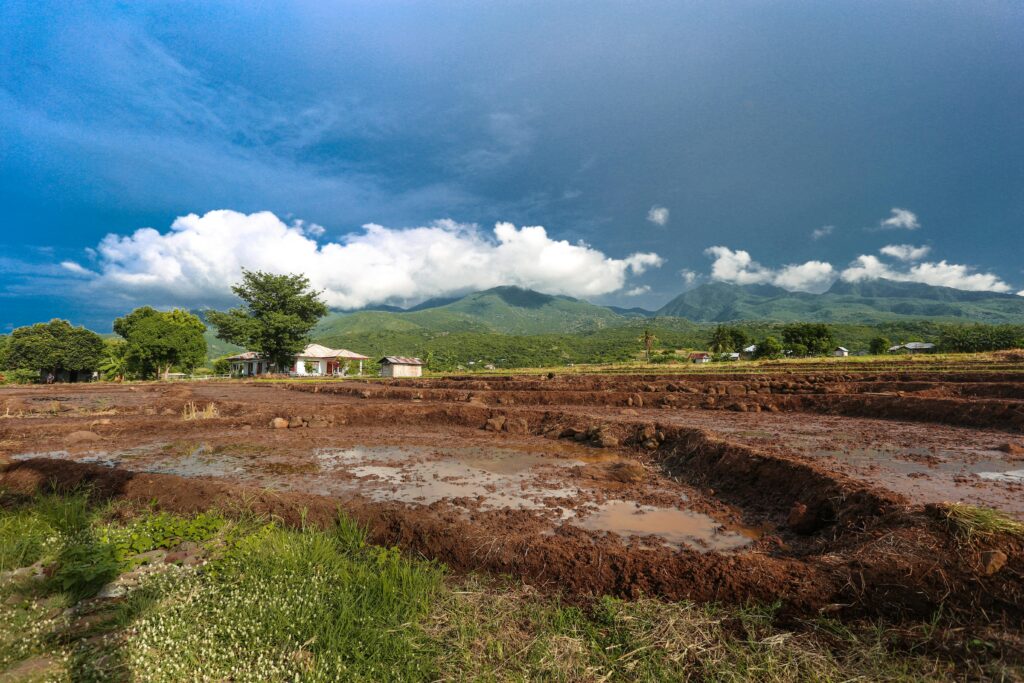
Soil erosion can sneak up on homeowners across Sarasota and much of Florida. Heavy rain, sloped yards, and sandy soils all speed up runoff and washouts!
The right trees make a big difference. With smart species selection and proper care, you can stabilize banks, protect foundations, and keep your yard healthy year-round.
Below, we share the best trees for erosion control, why they work, and how to plant and maintain them with confidence!
How Trees Help Prevent Erosion
Trees play a crucial role in preventing erosion. The fibrous and spreading roots grip soil, reduce runoff, and hold nutrients in place. Wide canopies also slow rainfall before it hits the ground.
Basically, trees act like a natural net and umbrella. The result is steadier soil, better drainage, and healthier groundcover across your property.
Here are some of the many benefits of planting trees to prevent erosion:
- Anchoring Soil: Tree roots spread deep and wide, binding soil particles together. This creates a strong network that stabilizes the ground and reduces soil displacement.
- Reducing Landslides: In hilly or sloped areas, deep-rooted trees provide structural support, reducing the risk of landslides or large-scale erosion.
- Rain Interception: Tree leaves, branches, and bark intercept falling rain, reducing the force with which raindrops hit the soil. This minimizes splash erosion, where raindrops dislodge soil particles.
- Slower Water Flow: Water drips gently from leaves rather than hitting the ground directly, allowing more water to soak into the soil instead of running off quickly.
- Ground Cover: Fallen leaves, needles, and branches form a natural mulch that covers the soil. This layer protects soil from direct impact, slows surface runoff, and improves moisture retention.
- Soil Health: As this litter decomposes, it adds organic matter, increasing soil structure and its ability to absorb and hold water.
- Obstructing Flow: Tree trunks and roots physically slow down moving water, reducing its ability to carry soil away.
- Enhanced Infiltration: With improved soil structure and more porous ground, rainwater infiltrates into the soil rather than washing across the surface.
- Windbreak effect: In areas prone to wind erosion, tree rows (windbreaks or shelterbelts) reduce wind speed near the ground, preventing loose soil from being blown away.
Top 10 Trees for Erosion Control

Florida’s climate is unique, which is why local species shine. The trees below are proven performers for Sarasota conditions and nearby coastal zones!
We recommend planting a mix of tree types to boost biodiversity and land resilience.
1. Bald Cypress
Fibrous roots and a deep anchoring habit make bald cypress ideal for wet sites, ponds, and shorelines. It excels at holding saturated soils and slowing erosion in flood-prone areas. These trees are also long-lived and add shade and character to water’s edge environments.
2. Southern Live Oak
Wide, dense roots spread far to secure large areas of soil. Its thick canopy slows rainfall, making it a reliable pick for sloped yards and high-traffic spaces. Live oaks also provide valuable wildlife habitat and can live for centuries, making them a strong long-term investment.
3. Longleaf Pine
A strong taproot helps this pine settle into sandy, coastal soils. It is a rugged choice for expansive properties that need dependable stabilization. Longleaf pines are also fire-resistant and support native ecosystems, adding both resilience and ecological value.
4. Red Maple
Fast growth and a dense, fibrous root system keep soil in place. A broad canopy offers added rainfall buffering, and fall color is a welcome bonus. Red maples thrive in both wet and dry conditions, making them versatile for erosion control.
5. Wax Myrtle
Compact and versatile, wax myrtle handles moist, sandy soils well. It’s a solid pick for smaller yards near wetlands or coastal areas. This evergreen shrub-tree also attracts birds and pollinators, adding biodiversity to erosion-prone zones.
6. River Birch
Well suited to stream banks and damp zones, river birch roots knit soil together and help rebuild damaged edges along waterways. Its peeling bark and graceful form make it as attractive as it is functional.
7. Florida Elm
Deep, spreading roots adapt to sand and clay. Use it to restore disturbed areas after construction or storm damage. Florida elms also grow quickly, offering fast relief in erosion-prone spaces.
8. Sabal Palm
Florida’s state tree has a sturdy, fibrous root system that grips sandy soils. It tolerates drought and proves useful in tough planting spots. Sabal palms also withstand hurricanes, making them a reliable choice for coastal erosion prevention.
9. Sweetbay Magnolia
Shallow but wide-spreading roots help stabilize moist areas. Fragrant blooms attract pollinators while its adaptability to wet soils makes it a natural fit for erosion-prone lowlands.
10. American Sycamore
The American sycamore grows quickly and thrives in floodplains, riverbanks, and other wet soils. Its wide root system grips soil effectively, making it excellent for stabilizing eroded areas. This tree also provides ample shade and is highly resilient to urban stress, making it useful for both natural and residential landscapes.
Top Tips to Prevent Erosion
In addition to planting trees, there are several other effective ways to prevent erosion.
Here are top tips for Florida property owners to consider:
- Plant Grass or Shrubs: Dense grass and shrubs provide a living cover that stabilizes soil and reduces water runoff.
- Use Native Plants: Native species are well-adapted to local conditions, require less maintenance, and have strong root systems that hold soil in place.
- Add Mulch & Ground Cover Crops: Mulch (wood chips, straw) protects soil from raindrop impact and reduces evaporation. Cover crops improve soil structure and add organic matter.
- Add Terracing Slopes: For steep areas, terracing creates level steps that slow down water flow and give it time to infiltrate.
- Install Retaining Walls: Rock or timber retaining walls help hold soil on slopes and prevent downhill erosion.
- Use Riprap or Gabions: Lining streambanks or shorelines with large rocks (riprap) or wire-mesh rock cages (gabions) helps dissipate water energy and prevent scouring.
- Create Rain Gardens & Swales: Create shallow basins or swales to capture and infiltrate runoff instead of letting it wash away soil.
- Install Diversion Channels: Direct water away from vulnerable areas using channels or berms to minimize concentrated flow.
- Maintain Proper Drainage: Ensure gutters, downspouts, and drains direct water safely away from slopes and bare soil.
- Cover Bare Soil: Never leave soil uncovered—use mulch, mats, or geotextiles (erosion control blankets) to protect it.
- Avoid Over-Tilling: Tilling disrupts soil structure and makes it more prone to erosion. Use no-till or low-till gardening methods when possible.
- Reduce Foot and Vehicle Traffic: Compaction makes soil less permeable and increases runoff. Designate paths and keep vehicles off vulnerable ground.
- Create “Buffer Zones”: Maintain vegetated buffer strips along waterways to absorb runoff and trap sediment.
Need More Help? Contact Harley’s Tree Service!
Planting the right mix of these trees can help you fight erosion and improve your property’s resilience. Our team at Harleys Tree Service can help you select, plant, and maintain the best erosion-control trees for your Florida yard.
Learn more about our tree planting services or explore our tree care solutions to keep your landscape strong and healthy for years to come.
